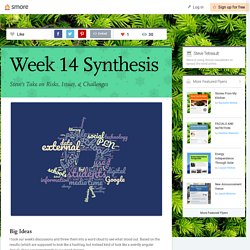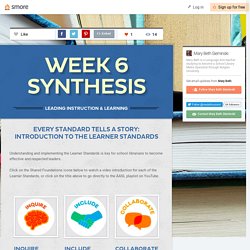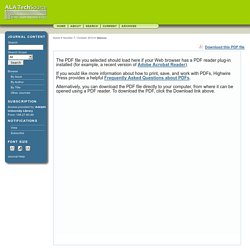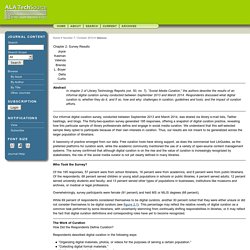

Week 14 Synthesis. Steve's Take on Risks, Issues, & Challenges Big Ideas I took our week's discussions and threw them into a word cloud to see what stood out.

Week 13: Obstacles & Opportunities (BYOR= Bring your own reading) Blended Learning. Google Docs vous permet de créer et de modifier des documents en ligne gratuitement. Apenas uma conta.

Tudo o que o Google oferece. 4th Gr. Primary Source: Declaration of Independence. Nikki Robertson Infographic. Home. American Indians in Children's Literature (AICL) Free data, statistics, analysis, visualization & sharing.
Week 9: Video for Instruction (*=Key reading) Week 7 - Digital Storytelling. Digital Storytelling. Libby. Smore Newsletters for Education. Leading Instruction & Learning Understanding and implementing the Learner Standards is key for school librarians to become effective and respected leaders.

Click on the Shared Foundations icons below to watch a video introduction for each of the Learner Standards, or click on the title above to go directly to the AASL playlist on YouTube. Discussion Recap: Special Needs Instruction Discussion Recap: Classroom Management There were so many strategies and ideas in this section! A Copyright-Friendly Toolkit. However fabulous Creative Commons and Public Domain content may be, sometimes you really need to use copyrighted material. Say you plan to comment on popular media or current events. For instance, you may be planning to critique the portrayal of Native Americans in commercial films.
You are going to want to “quote” some commercial films like Pocahontas, Lone Ranger, and Dances with Wolves. If you are reviewing a book, you may want to share its cover art. You may use copyrighted content without asking permission if you believe that your use falls under the doctrine known as Fair Use. In general, when you transform original content, repurpose it, and add value to it in your own remix, you may be able to claim the use fair. According to American University’s Center for Media and Social Impact, these two tests or questions help you plan whether to use the copyrighted work of others without asking permission: (Optional): Learning Standards / Anchor Charts Safari.
Share and Use Images with Openclipart. Unlimited Commercial Use We try to make it clear that you may use all clipart from Openclipart even for unlimited commercial use.

We believe that giving away our images is a great way to share with the world our talents and that will come back around in a better form. Curation for Teaching and Learning. Maslow's Hierarchy of Needs. Copyright Flowchart: Can I Use It? Yes? No? If This… Then… It is the responsibility of all educators to model good digital citizenship for their students.

Especially when it comes to copyright, plagiarism and intellectual property. The waters are murky. Not being familiar with online digital rights and responsibilities (hey, teachers did not grow up with the Internet being around), educators are wading through uncharted waters (hey, I did not know that I could not just google an image to use. If someone puts it up online it is free for the taking). That does not mean they can close their eyes and pretend life is the same or that the same rules apply to online versus offline use of copyrighted material with their students. It is every educator’s responsibility to become familiar , observe and model for their students! I have written about copyright on this blog many time. The waters are murky, it is not an easy topic. We have ubiquitous digital access, ease of duplication and distribution of information. Creativecommonsfairusepd. Chapter 1: Introduction. The PDF file you selected should load here if your Web browser has a PDF reader plug-in installed (for example, a recent version of Adobe Acrobat Reader).

If you would like more information about how to print, save, and work with PDFs, Highwire Press provides a helpful Frequently Asked Questions about PDFs. Alternatively, you can download the PDF file directly to your computer, from where it can be opened using a PDF reader. To download the PDF, click the Download link above. Fullscreen Fullscreen Off Refbacks There are currently no refbacks. Chapter 2: Survey Results. Our informal digital curation survey, conducted between September 2013 and March 2014, was shared via library e-mail lists, Twitter hashtags, and blogs.

The thirty-two-question survey generated 195 responses, offering a snapshot of digital curation practice, revealing how this particular sample of library professionals define and engage in social media curation. We understand that this self-selected sample likely opted to participate because of their own interests in curation. Thus, our results are not meant to be generalized across the larger population of librarians. A taxonomy of practice emerged from our data. Free curation tools have strong support, as does the commercial tool LibGuides, as the preferred platforms for curation work, while the academic community mentioned the use of a variety of open-source content management systems. Who Took the Survey? On building learning playlists. We create them on Spotify and YouTube and iTunes.

Before music went digital, some of us made CD or cassette mixtapes and shared them as gifts. With our ability to ethically curate content and unglue it from its containers, and a growing array of digital tools and open education resources, many of us are engaging in a creative new form of the remix. Learning playlists are a thing, and that thing is emerging as a subgenre of digital curation in a variety of flavors. Gene Luen Yang: Comics belong in the classroom. Create.piktochart.